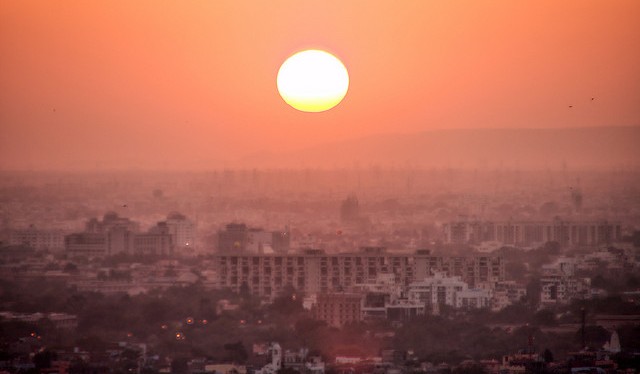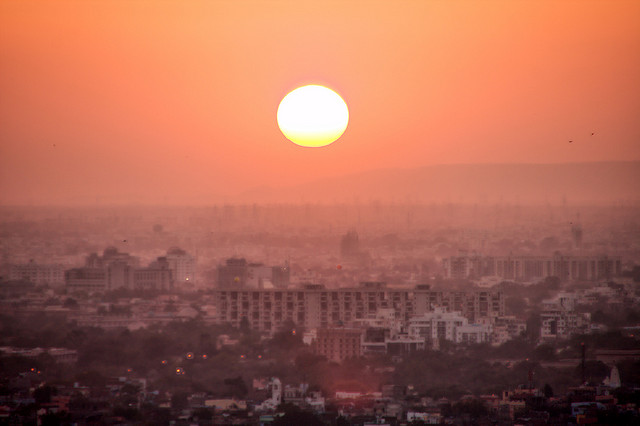By Divya Patwari
Rajasthan is my ancestral home. My great grandparents were originally from this region of India, so it is a place that is deeply close to my heart. There is a Rajasthani proverb which goes something like this: “Je na dekhiyo Jaipario, To kal men akar kya kario?” (What have I accomplished in my life if I have not seen Jaipur?) I think this holds so true for this eclectic city in India.
Whenever I visit Rajasthan and mainly Jaipur, I feel like I am back home. Stunning hill top forts, glorious palaces and a rich past of royalty, are just a few of the fascinating aspects that make a visit here worthwhile.
Jaipur is known as the Pink City, because of the vibrant terra-cotta-colored lime plaster that coats the old part of the city’s walls, buildings, and temples. The city is named after Maharaja Jai Singh II, an avid scientist, architect and astronomer who founded the city in 1727.
Summer months can be unbearably hot, so the perfect time to visit Rajasthan is actually October to mid February (winter season) when the days are warm and sunny — perfect for sightseeing.
On your visit to this magical city, I would encourage you to first check yourself into one of the two heritage hotels: Neemrana Fort Palace or Rambagh Palace.
Stay
Neemrana: This 15th-century fort, now a heritage hotel is one of the finest retreats in India, perched on a plateau in the Aravali Hills with stunning views. The rooms, which vary in size (the cheapest can be cramped), are masterpieces and the architecture is fascinating to explore.
Rambagh Palace: This romantic palace was once home to the Maharaja of Jaipur and his wife. It was one of the first hotels to be converted into a heritage hotel.

SIGHTS
They say Jaipur beams boldest at dusk, so start with visiting The Nahargarh Fort and admire the breathtaking view of the entire city as twilight fades.
Initially built by Sawai Jai Singh in 1734, it was enlarged to its sprawling, present-day glory in 1885 by Sawai Madho Singh. Cannons placed behind the walls recall the days when artillery was positioned against potential attackers below. The Rajasthan tourist board runs a terrace eatery at the fort, which provides tea, coffee and beer with a view.
For science lovers, Jantar Mantar is a must visit when in this city. It is an observatory begun by Jai Singh in 1728, which at first glance looks like a collection of mammoth, bizarre sculptures. The guided tour (30 minutes) is well worthwhile; guides provide explanations of how each of the fascinating instruments work, and how ““ through watching, recording and meticulous calculation — Jai Singh measured time by the course of the sun’s shadow and charted the annual progress through the zodiac.
City Palace is a perfect mix of Rajasthani and Mughal architecture. It includes Chandra Mahal and Mubarak Mahal. The Chandra Mahal is now a museum but the greatest part of it is still a royal residence. This impressive palace encompasses a vast complex of courtyards, gardens and buildings.
A “Royal Grandeur” tour is available, taking you close to the royal family’s quarters and their guest rooms.
Amber Fort: For centuries the fortress was the capital of the Kachhawh Rajputs, but when the capital shifted to Jaipur in the early 18th century, the site was abandoned. Although the fort is in ruins, the interior palaces, gardens, and temples retain much of their pristine beauty.
Chokhi Dhani: Located 15 kms from Jaipur, Chokhi Dhani is a magical virtual village. Chokhi Dhani literally means “˜fine hamlet’. The culture of Rajasthan is recreated here with traditional tribal dancers- Rajasthani Kalbeliya performers; small children balancing on poles, and dancers dressed in lion costumes.
The food is complete Rajasthani cuisine with typical Dal (lentils), Bati (hard wheat rolls) and Churma (wheat crushed and cooked with ghee and sugar). It should be eaten traditionally: first coarsely mash the bati and pour pure ghee (butter) atop, then mix the lentils and Churma with it.
I assure you; you will want the recipe to take back home.

Photo by Rishu83
EAT
Rajasthan’s culinary traditions are heavily influenced by its desert setting. Food tends to be highly spicy.
Rawat Kachoris is a must visit in Jaipur. It is my personal favorite as it has the best milk cakes the world over.
It is also very famous for Kachoris, which is a very popular snack in India. Rawat’s specialty is Onion Kachoris. It is a round flat ball made of fine flour filled with a stuffing of yellow moong dal (crushed and washed horse beans), besan (crushed and washed gram flour), black pepper and chilli powder, chopped onions and other Indian spices.
Rawat’s also has delicious “˜Ghevar’, which is a Rajasthani sweet. It is a disc shaped dish, made from oil, flour, and sugar syrup. When you visit Jaipur, tasting this delicacy is a must.
Handi restaurant is an old favorite in Jaipur. It offers an array of delicious barbecue dishes and Mughlai cuisine in a village atmosphere. In the evenings, they set up smoky kebab stalls at the entrances. For mouth watering Chicken Tikka and Murgh Makhani one should not miss this place.
Lassiwala: Lassiwala has delicious creamy yoghurt (mixed with filtered ice water) served in clay cups. Make sure to visit Lassiwala before 1 p.m. as “˜Lassi’ usually runs out after that.
Laxmi Mishthan Bhandaar: When you are headed to Johari Bazaar to shop (a popular shopping area to visit in the city), make sure you stop at his restaurant. There is an array of delicious sweets displayed here, but the divine malpuas (Indian pancakes) are a must.

Photo by RussBowling
SHOP
Anokhi: This classy boutique is well worth visiting, with high quality fabrics and clothing. The collection features beautiful block prints and Kurtas (Indian suits).
Amrapali Jewels: This one is especially for women. It is a favorite among Indians for its whimsical silver, ornamental trinkets, and semi precious stone artifacts. The name stems from an ancient legend. “˜Amrapali’ was believed to have lived during the time of Lord Buddha as a legendary courtesan. She is known to be the most beautiful woman in the history of the world.
Artchill: This is Jaipur’s legendary gallery of contemporary art. It has a wide-ranging collection of oil paintings, watercolors, and graphics by eminent artists such as Jatin Das, and Arpana Caur, and Paritosh Sen.
Johari Bazaar: This is where you can buy tie dyed sarees and jewellery at very reasonable prices!
Jaipur, with its bustling bazaars, world-class hotels, neon pink turbans, lehariya saree clad women, striking desert landscapes and camel carts and cows wandering the streets, continues to fascinate newcomers and residents alike. For me, it represents home, but for many it is quintessential India.
 ABOUT THE WRITER
ABOUT THE WRITER
Hailing from Assam, India, Divya Patwari is an avid tea drinker who holds a Bachelors degree in Political Science and a Masters in Fashion Management. She is always “˜in pursuit of happiness’ and wishes to travel all across Europe. Patwari’s studied John Locke and Rousseau, loves Julius Caesar and has a knack for reading minds. She’s always in love and welcomes you to join her in finding out the “˜Joie De Vivre’ together.
Feature photo by Christian Haugen




